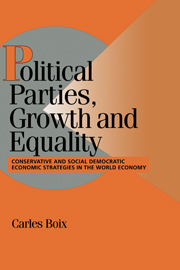 Political Parties, Growth and Equality
Political Parties, Growth and Equality Book contents
- Frontmatter
- Contents
- List of Tables and Figures
- Preface
- 1 Introduction
- 2 Political Parties and the Structural Conditions of the Economy
- 3 Supply-Side Economic Strategies from a Comparative Perspective (I): Public Investment and the Formation of Human Capital
- 4 Supply-Side Economic Strategies from a Comparative Perspective (II): The Public Business Sector and Tax Strategies
- 5 The Social Democratic Project: Macroeconomic Stability and State Intervention in Spain
- 6 The Political and Electoral Dimensions of the PSOE's Economic Strategy
- 7 Turning around the Postwar Consensus: Defining a Conservative Economic Framework in Britain
- 8 The Political and Electoral Dimensions of the Conservative Economic Strategy
- 9 Partisan Strategies and Electoral Coalitions
- 10 Conclusions
- Notes
- References
- Index
- More Titles in the Series
10 - Conclusions
Published online by Cambridge University Press: 05 June 2012
- Frontmatter
- Contents
- List of Tables and Figures
- Preface
- 1 Introduction
- 2 Political Parties and the Structural Conditions of the Economy
- 3 Supply-Side Economic Strategies from a Comparative Perspective (I): Public Investment and the Formation of Human Capital
- 4 Supply-Side Economic Strategies from a Comparative Perspective (II): The Public Business Sector and Tax Strategies
- 5 The Social Democratic Project: Macroeconomic Stability and State Intervention in Spain
- 6 The Political and Electoral Dimensions of the PSOE's Economic Strategy
- 7 Turning around the Postwar Consensus: Defining a Conservative Economic Framework in Britain
- 8 The Political and Electoral Dimensions of the Conservative Economic Strategy
- 9 Partisan Strategies and Electoral Coalitions
- 10 Conclusions
- Notes
- References
- Index
- More Titles in the Series
Summary
One of the most striking developments in the discipline of political science today is the extent to which the research on democratic politics and performance and the literature on political economy are at odds with each other. On the one hand, political scientists have managed to accumulate an impressive array of knowledge and models on political participation, the formation of voter attitudes, electoral behavior, and partisan competitive strategies that provides very powerful insights on the workings of modern mass democracies. On the other hand, however, political economists have downplayed the significance of voter preferences and partisan programs to explain policies and economic outcomes. Until the early 1980s, corporatism, that is, the continuous bargaining among organized economic interests, was offered as the paradigm of how politics was (or ought to be) conducted in most parts of the advanced industrial world. Several scholars then turned to the analysis of the state and its political institutions to account for the notoriously different levels of inflation and budget deficits that the OECD countries experienced in the aftermath of several consecutive oil shocks. Today many have decided that globalization and economic interdependence are finally washing out any differences that may remain among nations. What all these research agendas have in common, however, is the rather tangential role they have ascribed to electoral politics and the impact of partisanship.
This study does not try to overturn all these explanations. Domestic institutions and the various constraints imposed by the international economy are clearly needed to understand the different political–economic equilibria that characterize advanced countries.
- Type
- Chapter
- Information
- Political Parties, Growth and EqualityConservative and Social Democratic Economic Strategies in the World Economy, pp. 219 - 231Publisher: Cambridge University PressPrint publication year: 1998
